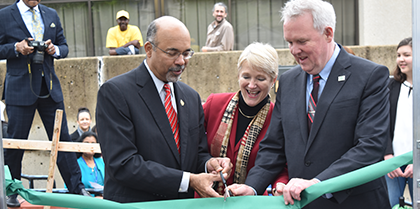
On April 25th, 2017 the College of Agriculture Urban Sustainability and Environmental Sciences (CAUSES) held the official ribbon cutting ceremony for its newest aquaponics system
CAUSES held the official ribbon cutting ceremony for its newest aquaponics system located at UDC-Van Ness campus.
On April 25th, 2017, the University of the District of Columbia’s (UDC) College of Agriculture Urban Sustainability and Environmental Sciences (CAUSES) held the official ribbon cutting ceremony for its newest aquaponics system located at UDC-Van Ness campus. Stakeholders and community members participated in a tour of the greenhouse, demonstrations of the aquaponics system and witnessed remarks by Dr. Sabine O’Hara, Dean of CAUSES & Director of the University’s Landgrant Programs, Ronald Mason, President & Interim CAO of UDC and Tommy Wells, Director of Department of Energy & Environment.
Aquaponics — a combination of hydroponics (growing plants in nutrient rich water) and aquaculture (fish production) — is a growing field that presents not only potential career options but helps students learn about fish and plant life, photosynthesis and life cycles. In an aquaponics system, fish and plants grow together. The systems convert waste produced by the fish into fertilizer for plants, which in turn filter water that enters the fish habitat. The new system coincides with CAUSES’ mission of creating economic self-sufficiency through the building of green jobs and community ownership.


UDC was awarded a grant to establish and operate four aquaponic demonstration projects in Wards 3, 5, 7 and 8. In May 2016, UDC held a ribbon-cutting for its first aquaponics facility at the East
Capitol Urban Farm in Ward 7. UDC’s continued growth in aquaponics will serve as a base for job-skills and entrepreneurship training for low-skilled and semi-skilled District residents. When combined with a small greenhouse, each facility is expected to generate 500 pounds of fish and 5,000 pounds of produce annually.
